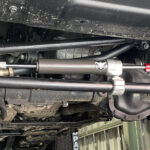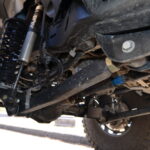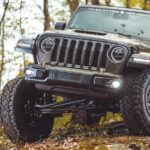
Adjustable track bar in Jeep: How to avoid handling issues and enhance off-road performance?
Damn Jeep – you’ve probably sworn at your vehicle more than once. Driving an off-road vehicle isn’t always easy, especially once you start seriously modifying it. If you’ve ever experienced uncontrollable steering wheel vibrations on the road, you know exactly what I mean.
But that doesn’t mean you should give up. When modifying your vehicle’s suspension, you need to carefully address a lot of factors—things you wouldn’t normally think about. One of them is the track bar (Panhard bar/rode). Do you know why you need an adjustable one? Keep reading, and you might stop blaming your beloved Jeep.
How the track bar works
To start off, here are a few basic facts. The Panhard rod can be found in off-road vehicles like the Jeep, which have dependent suspension based on a solid axle. It’s a guiding component located both at the front and rear, installed transversely to the vehicle. It is connected with silent block bushings, which let it move up and down while allowing the wheels to move forward and backward. The track bar is responsible for:
- Controlling the lateral movement of the wheels,
- Centering the vehicle’s axle,
- Maintaining the correct suspension geometry.
The track bar mainly works when turning, as the load shifts to the outside of the vehicle, and when hitting bumps, acceleration, or braking. That’s why a faulty bar, especially if its parts are worn out, can lead to a loss of stability. Additionally, if the bar is the wrong length and operates at extreme angles, it can cause bump steer. This happens when the wheel turns on its own as the suspension compresses. It can also lead to those annoying steering wheel vibrations we mentioned earlier, known as death wobble.
Common issues with stock Panhard rods and their causes
Stock Panhard rods in both standard and modified vehicles can have various problems. However, in highly modified Jeeps, the main issue is often the track bar itself, which is not built for heavy-duty off-roading.
This is especially noticeable with weak bushings, rods that are too thin, or rods with insufficient bends. For example, the factory straight rear track bar in the Gladiator can make it impossible to fit a larger spare tire under the chassis. An aftermarket one with a better bend reduces the risk of it hitting the axle or other components.
Regardless of the Jeep model, if you’ve noticed steering or handling issues—such as feeling that the axles are wandering while driving straight or around corners – it’s time to check the Panhard rod. Pay special attention to:
- The condition of the bushings,
- Looseness in the bolts attaching the track bar to the frame,
- Irregularities in the factory mounting holes (e.g. whether they are worn out),
- Proper installation of the track bar,
- Looseness at the Panhard rod end (only for aftermarket ones).
You can learn how to test the Panhard rod in How to fix death wobble? Checking for slack in the suspension. Don’t ignore even minor issues, as a worn track bar negatively affects other suspension parts, reducing their lifespan.
The Panhard Rod in a Lifted Jeep – What’s the Deal?
Worn or low-quality parts aren’t the only problems with the Panhard rod. The most significant and risky issue is its length – or rather, its lack of sufficient length.
When you lift your Jeep by 2.5 inches, the stock track bar becomes too short, which means it will pull the axle to one side, seriously messing up the suspension geometry. I Improper angles will cause the vehicle to drift, reduce traction, and ultimately compromise driving safety. To be blunt – you shouldn’t drive it this way if you value your life.
So how can you tell if your Panhard bar is too short? Stand in front of your vehicle and look closely. You’ll notice that one of the axles is off-center. In cases with a too-short track bar, this will be most apparent with the driver’s side tire, which will stick out more compared to the other.
Relocating the factory track bars
Moreover, even a ‘modest’ 2-inch lift affects how suspension components align with each other and the vehicle. You have at least two solutions: replace the stock Panhard bar with a longer one or install a track bar relocation bracket.
A Panhard rod relocation bracket raises the mounting point on the vehicle’s axle. This adjustment changes the rod’s angle, helping to center the axle and giving more working space to other suspension parts without replacing the stock track bar. It’s also the most economical upgrade and works well for casual driving and small lifts. .
Adjustable track bar vs. lift height
An adjustable Panhard rod offers the most benefits. It allows you to fine-tune its length to match the suspension lift and the resulting changes in geometry.
Proper suspension geometry tailored to your preferences improves flexibility, traction, and stability – all essential for off-road driving. For lifts of 2.5 inches or more, this modification is absolutely necessary.
For higher lifts, from the common 4-inch to 6-inch ones found in Jeeps, we recommend combining both upgrades: a relocation bracket and an adjustable Panhard rod. This ensures you get the advantages of both.
Why an Adjustable Panhard Rod Is Worth the Investment
An adjustable track bar is an investment that will pay off in the long run. It allows you to adjust the length to the changed suspension geometry, not only after lifting the vehicle but also when dealing with sagging, for example, due to extra weight.
Additionally, aftermarket track bars often come with extra benefits that boost off-road performance. High-quality bushings, such as Johnny Joint or Giiro from Clayton Off Road, offer a wider range of motion and greater durability. Panhard rodes from brands like Rough Country or Rubicon Express are made from forged steel, providing better axle positioning and greater strength in off-road conditions.
So, before you start swearing at your Jeep again, check if the track bar is due for an upgrade.









Comments ()